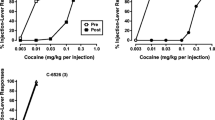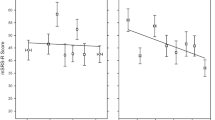Abstract
In humans, CSF monoamine metabolite concentrations have been shown to vary as a complex function of age, sex, psychiatric diagnosis, and stress. To test for such relationships in rhesus monkeys, 28 subjects, reared either in anxiety producing peer-only groups or in mother-infant dyads, were studied at 6, 18 or 50 months of age. Each monkey underwent a series of four 4-day social separations, each followed by 3 days of reunion. Prior to and during the first and fourth separations, CSF was obtained from the cisterna magna and assayed for the serotonin metabolite 5-HIAA, the dopamine metabolite HVA, and the norepinephrine metabolite MHPG. CSF 5-HIAA showed an age-related decline which was greater in the mother-reared subjects. Peer-only-reared males had an increased 5-HIAA concentration relative to females, and higher 5-HIAA levels than mother-reared males. MHPG was also higher in peer-only-reared monkeys than in mother-reared subjects at all ages. In both groups HVA declined across the three ages, and MHPG increased from the 18- to the 50-month measurements. Both MHPG and 5-HIAA concentrations increased during the initial social separation, although only MHPG remained elevated across the repeated separations; HVA, on the other hand declined during social separation. These results are discussed in terms of established anxiety and aggression differences between peer-only and mother-reared monkeys.
Similar content being viewed by others
References
Andersson H, Roos BE (1969) 5-Hydroxyindoleacetic acid in cerebrospinal fluid of hydrocephalic children. Acta Paediatr Scand 58:601–608
Asberg M, Schalling D, Traskman-Bendz L, Wagner A (1987) Psychobiology of suicide, impulsivity, and related phenomena. In: Meltzer HY (ed) Psychopharmacology: the third generation of progress. Raven Press, New York, pp 655–668
Bacopoulos NG, Redmond DE, Roth RH (1979) Serotonin and dopamine metabolites in brain regions and cerebrospinal fluid of a primate species: effects of ketamine and fluphenazine. J Neurochem 32:1215–1218
Bernstein I, Williams L, Ramsay M (1983) The expression of aggression in old world monkeys. Int J Primatol 4:113–124
Chamove AS, Rosenblum LA, Harlow HF (1973) Monkeys(Macaca mulatta) raised only with peers. A pilot study. Anim Behav 21:316–325
Coelho AM, Bramblett CA (1981) Effects of rearing on aggression and subordination in papio monkeys. Am J Primatol 1:401–412
Cohen DJ, Shaywitz BA, Johnson WT, Bowers M (1974) Biogenic amines in autistic and atypical children: cerebrospinal fluid measures of homovanillic acid and 5-hydroxyindoleacetic acid. Arch Gen Psychiatry 31:845–853
Cross HA, Harlow HF (1965) Prolonged and progressive effects of partial isolation on the behavior of macaque monkeys. J Exp Res Pers 1:39–49
den Boer JA, Westerberg HGM (1988) Evidence for a serotonergic dysfunction in panic disorder. In: Swinkels JA, Blijleven W (eds) Depression, anxiety and aggression. Medidact, Amsterdam, pp 167–172
Duncan DB (1955) Multiple range and multiple F tests. Biometrics 11:1–42
Eichelman B (1987) Neurochemical and psychopharmacologic aspects of aggressive behavior. In: Meltzer HY (ed) Psychopharmacology: the third generation of progress. Raven Press, New York, pp 697–704
Elsworth JD, Leahy DJ, Roth RH, Redmond Jr DE (1987) Homovanillic acid concentrations in brain, CSF and plasma as indicators of central dopamine function in primates. J Neural Transm 68:51–62
Goldman-Rakic PS, Brown PS, Brown RM (1981) Regional changes of monoamines in cerebral cortex and subcortical structures of aging rhesus monkeys. Neuroscience 6:177–187
Goldman-Rakic PS, Brown PS, Brown RM (1982) Postnatal development of monoamine content and synthesis in the cerebral cortex of rhesus monkeys. Brain Res 256:339–349
Harlow HF, Harlow MK (1969) Effects of various mother-infant relationships on rhesus monkey behaviors. In: Foss BM (ed) Determinants of infant behavior, vol 4. Methuen, London, pp 15–36
Higley JD, Suomi SJ (1989) Temperamental reactivity in nonhuman primates. In: Kohnstamm D, Bates JE, Rothbart MK (eds) Temperament in childhood. Wiley, Chichester, England, pp 153–167
Higley JD, Suomi SJ, Linnoila M (1990) Parallels in aggression and serotonin: consideration of development, rearing history, and sex differences. In: van Praag HM (ed) Violence and suicidality perspectives in clinical and psychobiological research. Brunner/Mazel Press, New York, pp 245–256
Higley JD, Suomi SJ, Linnoila M (1990) Serotonin in nonhuman primates: Gender, rearing, and developmental correlates with behavioral timidity and affective psychopathology. In: Coccaro EF, Murphy DL (eds) Serotonin in major psychiatric disorders. American Psychiatric Press, Inc.: APA Press Progress in Psychiatry Monograph Series, Washington, DC, pp 27–46
Hoehn-Saric R (1982) Neurotransmitters in anxiety. Arch Gen Psychiatry 39:735–742
Knott P, Haroutunian V, Bierer L, Perl D, Handler M, DeLeon M, Yang R, Davis K (1989) Correlation post-mortem between ventricular CSF and cortical tissue concentrations of MHPG, 5-HIAA and MHPG in Alzheimer's disease. Biol Psychiatry [Suppl] 25:112A (Abstract)
Kraemer GW, Ebert MH, Schmidt DE, McKinney WT (1989) A longitudinal study of the effect of different social rearing conditions on cerebrospinal fluid norepinephrine and biogenic amine metabolites in rhesus monkeys. Neuropsychopharmacology 2:175–189
Langlais PJ, Walsh FX, Bird ED, Levy HL (1985) Cerebrospinal fluid neurotransmitter metabolites in neurologically normal infants and children. Pediatrics 75:580–586
Leckman JF, Cohen DJ, Shaywitz BA, Caparulo BK, Heninger GR (1980) CSF monoamine metabolites in child and adult psychiatric patients. Arch Gen Psychiatry 37:677–681
Linnoila M (1988) Monoamines and impulse control. In: Swinkels JA, Blijleven W (eds) Depression, anxiety and aggression: factors that influence the course. Medidact Medical Didactic Systems, Amsterdam, pp 167–172
Mann JJ, Stanley M (1986) Psychobiology of suicidal behavior (special issue). Ann NY acad Sci: 487
McKinney WT (1988) Models of mental disorders: a new comparative psychiatry. Plenum, New York
Meltzer HY, Lowy MT (1987) The serotonin hypothesis of depression. In: Meltzer HY (ed) Psychopharmacology: the third generation of progress. Raven Press, New York, pp 513–526
Miczek KA, Donat P (1989) brain 5-HT systems and inhibition of aggressive behavior. In: Bevan P, Cools AR, Archer T (eds) Behavioral pharmacology of 5-HT. Lawrence Erlbaum, Hillsdale, New Jersey, pp 117–145
Mineka S, Suomi SJ, DeLizio R (1981) Multiple separations in adolescent monkeys: an opponent-process interpretation. J Exp Psychol 110:56–85
Mitchell GD (1979) Behavioral sex differences in nonhuman primates. Van Nostrand, New York, pp 374–401
Olivier B, Mos J (1988) Serotonin, serenics and aggressive behaviour in animals. In: Swinkels JA, Blijleven W (eds) Depression, anxiety and aggression: factors that influence the course. Medidact Medical Didactic Systems, Amsterdam, pp 133–165
Olivier B, Mos J, Tulp M, Schipper J, Daas SD, Oortmerssen GV (1990) Serotonergic involvement in aggressive behavior in animals. In: van Praag HM (ed) Violence and suicidality: perspectives in clinical and psychobiological research. Brunner/Mazel Press, New York, pp 79–140
Redmond Jr DE (1987) Studies of the nucleus locus coeruleus in monkeys and hypotheses for neuropsychopharmacology. In: Meltzer HY (ed) Psychopharmacology: the third generation of progress. Raven Press, New York, pp 967–975
Rogers KJ, Dubowitz V (1970) 5-hydroxyindoles in hydrocephalus: a comparative study of cerebrospinal fluid and blood levels. Dev Med Child Neurol 11:461–466
Roy A, Pickar D, Linnoila M, Doran AR, Paul SM (1986) Cerebrospinal fluid monoamine and monoamine metabolite levels and the dexamethasone suppression test in depression. Arch Gen Psychiatry 43:356–360
Scheinin M, Chang WH, Kirk KL, Linnoila M (1983) Simultaneous determination of 3-methoxy-4-hydroxyphenylgycol, 5-hydroxy-indoleacetic acid, and homovanillic acid in cerebrospinal fluid with high performance liquid chromatography usin electrochemical detection. Anal Biochem 131:246–253
Seegal RF (1985) Lumbar cerebrospinal fluid homovanillic acid concentrations are higher in female than male non-human primates. Brain Res 334:375–379
Seifert WE, Fox JL, Butler IJ (1980) Age effect on dopamine and serotonin metabolite levels in cerebrospinal fluid. Ann Neurol 8:38–42
Shelton SE, Kalin NH, Gluck JP, Keresztury MF, Schneider VA, Lewis MH (1988) Effect of age on cisternal cerebrospinal fluid concentrations of monoamine metabolites in nonhuman primates. Neurochem Int 13:353–357
Siever LJ (1987) Role of noradrenergic mechanisms in the etiology of the affective disorders. In: Meltzer HY (ed) Psychopharmacology: the third generation of progress. Raven Press, New York, pp 493–504
Silverstein FS, Johnston MV, Hutchinson RJ, Edwards NL (1985) Lesch-Nyhan syndrome: CSF neurotransmitter abnormalities. Neurology 35:907–911
Smuts BB (1987) Gender, aggression, and influence. In: Smuts BB, Cheney DL, Seyfarth RM, Wrangham RW, Struhsaker TT (eds) Primate societies. The University of Chicago Press, Chicago London, pp 400–412
Stein L (1981) Behavioral pharmacology of benzodiazepines. In: Klein DF, Rabkin J (eds) Anxiety: new research changing concepts. Raven Press, New York, pp 201–213
Suomi SJ (1982) Abnormal behavior in nonhuman primates. In: Fobes JL, King JE (eds) Primate behavior. Academic Press, New York, pp 171–215
Young SN, Ervin FR (1984) Cerebrospinal fluid measurements suggest precursor availability and sex are involved in the control of biogenic amine metabolism in a primate. J Neurochem 42:1570–1573
Author information
Authors and Affiliations
Rights and permissions
About this article
Cite this article
Higley, J.D., Suomi, S.J. & Linnoila, M. CSF monoamine metabolite concentrations vary according to age, rearing, and sex, and are influenced by the stressor of social separation in rhesus monkeys. Psychopharmacology 103, 551–556 (1991). https://doi.org/10.1007/BF02244258
Received:
Revised:
Issue Date:
DOI: https://doi.org/10.1007/BF02244258




